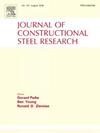Experimental assessment on structural behaviour of short concrete-filled S690 steel tubes
IF 4
2区 工程技术
Q1 CONSTRUCTION & BUILDING TECHNOLOGY
引用次数: 0
Abstract
A systematic assessment on the structural behaviour of short concrete-filled columns with S690 square and circular steel tubes under compression is presented. A total of 32 compression tests were conducted on two types of short columns, i.e. steel columns and concrete-filled steel tubes. Steel tubes with S355 to S690, and C60/75 concrete were employed in these compression tests. It is shown that concrete-filled circular steel tubes with S690 steel and C60/75 concrete exhibit high ductility under compression, and significant enhancement in their compression resistances is readily achieved. However, for those concrete-filled square steel tubes with S690 steel and C60/75 concrete, only limited ductility and enhancement under compression is attained. Through comprehensive analyses on measured strains of the steel tubes of both the steel columns and the concrete-filled steel tubes, the section resistances provided by the steel tubes and the infilled concrete are successfully quantified. Despite the design rules in EN 1994–1 are recommended for composite columns up to S460 steel and C50/60 concrete, it is demonstrated that these rules are equally applicable to concrete-filled steel tubes with S690 steel and C60/75 concrete after comparison with the 16 test data reported in this paper and other 38 test data reported in the literature. However, significant discrepancies on individual resistances between the measured and the predicted values of the steel tubes and the infilled concrete are found, indicating that it is necessary to improve predictability of these design rules.
求助全文
约1分钟内获得全文
求助全文
来源期刊

Journal of Constructional Steel Research
工程技术-工程:土木
CiteScore
7.90
自引率
19.50%
发文量
550
审稿时长
46 days
期刊介绍:
The Journal of Constructional Steel Research provides an international forum for the presentation and discussion of the latest developments in structural steel research and their applications. It is aimed not only at researchers but also at those likely to be most affected by research results, i.e. designers and fabricators. Original papers of a high standard dealing with all aspects of steel research including theoretical and experimental research on elements, assemblages, connection and material properties are considered for publication.
 求助内容:
求助内容: 应助结果提醒方式:
应助结果提醒方式:


